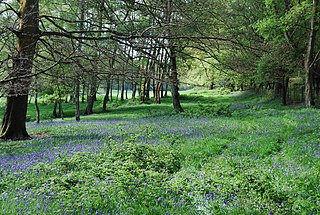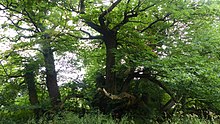
The chestnuts are the deciduous trees and shrubs in the genus Castanea, in the beech family Fagaceae. They are native to temperate regions of the Northern Hemisphere.

Coppicing is a traditional method of woodland management which exploits the capacity of many species of trees to put out new shoots from their stump or roots if cut down. In a coppiced wood, which is called a copse, young tree stems are repeatedly cut down to near ground level, resulting in a stool. New growth emerges, and after a number of years, the coppiced tree is harvested, and the cycle begins anew. Pollarding is a similar process carried out at a higher level on the tree in order to prevent grazing animals from eating new shoots. Daisugi, is a similar Japanese technique.

The Woodland Trust is the largest woodland conservation charity in the United Kingdom and is concerned with the creation, protection, and restoration of native woodland heritage. It has planted over 50 million trees since 1972.

Greenwich Park is a former hunting park in Greenwich and one of the largest single green spaces in south-east London. One of the Royal Parks of London, and the first to be enclosed, it covers 74 hectares, and is part of the Greenwich World Heritage Site. It commands views over the River Thames, the Isle of Dogs and the City of London.

Castanea sativa, the sweet chestnut, Spanish chestnut or just chestnut, is a species of tree in the family Fagaceae, native to Southern Europe and Asia Minor, and widely cultivated throughout the temperate world. A substantial, long-lived deciduous tree, it produces an edible seed, the chestnut, which has been used in cooking since ancient times.

Earl of Ducie is a title in the Peerage of the United Kingdom. It was created in 1837 for Thomas Reynolds Moreton, 4th Baron Ducie.
Falfield is a village, located near the northern border of the South Gloucestershire district of Gloucestershire, England on the southern edge of the Berkeley Vale, to the east of the River Severn and just falling into the boundary of the Cotswolds. It is the last parish on the northern boundary of South Gloucestershire. The area has a Wotton-under-Edge (GL12) post code and so is often incorrectly listed as being in the Stroud district of Gloucestershire. Falfield is one of the longest villages in England, alongside local village Cromhall.

St Leonards-on-Sea is a town and seaside resort in the Borough of Hastings in East Sussex, England. It has been part of the borough since the late 19th century and lies to the west of central Hastings. The original part of the settlement was laid out in the early 19th century as a new town: a place of elegant houses designed for the well-off; it also included a central public garden, a hotel, an archery, assembly rooms and a church. Today's St Leonards has extended well beyond that original design, although the original town still exists within it.

Tortworth Court is a Victorian mansion in Tortworth near Thornbury, South Gloucestershire. England. It was built in Tudor style for the 2nd Earl of Ducie. It is a Grade II* listed building.

Tormarton is a village in South Gloucestershire, England. Its name may come from Thor Maer Tun meaning The settlement with the thorn (tree) on the boundary. Another source suggests the name derives from the church tower (Tor) on the border between Wessex and Mercia. It is one mile North-East of junction 18 of the M4 motorway, with the A46 road and close to the border between Wiltshire and South Gloucestershire. In 2001 and 2011 there were 144 households and the population was 348. A National Trail, the Cotswold Way passes through the village. There is a church, a hotel, a pub and also a number of bed and breakfasts in the village. A Highways Agency depot with a salt dome is situated near to the village.

Tortworth is a small village and civil parish, near Thornbury in Gloucestershire, England. It has a population of 147 as of 2011. It lies on the B4509 road, which crosses the M5 motorway to the west of Tortworth.

Danny House is a Grade I listed Elizabethan red brick mansion near Hurstpierpoint in West Sussex, England. It lies at the northern foot of Wolstonbury Hill and may be regarded as one of the finest stately houses in Sussex, with 56 bedrooms and 28 apartments. The present house was built 1593–95 by George Goring, on the site of an older house. It is set in eight acres of gardens at the foot of the South Downs within an historic parkland of some 400 acres, which was granted by royal charter in 1333.

There have been two baronetcies created for different branches of the Throckmorton family, 6th cousins, both descended from Sir John Throckmorton, Under-Treasurer of England temp. King Henry VI (1422–1461). Both titles, which were in the Baronetage of England, are now extinct. The Throckmortons, originally of Throckmorton near Pershore, Worcestershire, trace their history back to the 12th century. In 1409 Sir John de Throckmorton, Under-Treasurer of England, married Eleanor Spinney, daughter and heiress of Guy Spinney of Coughton, Warwickshire, where the senior branch of the family, which bore the junior baronetcy, became established. The Coughton estate included in 1968 a dower house named "Spiney House, Coughton", named after that family. The senior Throckmorton Baronetcy, of Tortworth in the County of Gloucester, was created in the Baronetage of England on 29 June 1611 for William Throckmorton, of Coss Court, Tortworth, Gloucestershire, sixth in descent from John Throckmorton, younger son of Sir John Throckmorton, Under-Treasurer of England. The third Baronet sat as Member of Parliament for Gloucestershire and Wotton Basset. The title became extinct on the death of the fourth Baronet in a duel in 1682.

St Leonard's Forest is at the western end of the Wealden Forest Ridge which runs from Horsham to Tonbridge, and is part of the High Weald Area of Outstanding Natural Beauty. It lies on the ridge to the south of the A264 between Horsham and Crawley with the villages of Colgate and Lower Beeding within it. The A24 lies to west and A23 to the East and A272 through Cowfold to the south. Much has been cleared, but a large area is still wooded. Forestry England has 289 ha. which is open to the public, as are Owlbeech and Leechpool Woods to the east of Horsham, and Buchan Country Park to the SW of Crawley. The rest is private with just a few public footpaths and bridleways. Leonardslee Gardens were open to the public until July 2010 and re-opened in April 2019. An area of 85.4 hectares is St Leonards Forest Site of Special Scientific Interest.

Manor Park Country Park is a country park in West Malling, Kent, England. The 52-acre (210,000 m2) park, formerly the private gardens of the nearby Douces Manor, was purchased from the manor's owners by Kent County Council in 1973 to be converted into a public open space. The park is legally protected as public recreational land in perpetuity by Fields in Trust as part of the Queen Elizabeth II Fields Challenge.

Collinpark Wood is a 66.69-hectare (164.8-acre) biological Site of Special Scientific Interest in Gloucestershire, notified in 1966, revised in 1974 and renotified in 1983. There was a boundary change in 1983. There are seven units of assessment. Unit 1 is a 15-hectare (37-acre) area owned and managed by the Gloucestershire Wildlife Trust. The trust purchased this part of the wood in 1979 with grant aid from WWF. The site is listed in the 'Forest of Dean Local Plan Review' as a Key Wildlife Site (KWS).

The Queen Elizabeth Oak is a large sessile oak tree in Cowdray Park near the village of Lodsworth in the Western Weald, West Sussex, England. It lies within the South Downs National Park. It has a girth of 12.5–12.8 metres (41–42 ft), and is about 800–1,000 years old. According to this estimate it began to grow in the 11th or 12th century AD. In June 2002, The Tree Council designated the Queen Elizabeth Oak, one of fifty Great British Trees, in recognition of its place in the national heritage. According to the Woodland Trust, the tree is the third largest sessile oak tree to be recorded in the United Kingdom after the Pontfadog Oak in Wales and the Marton Oak in Cheshire, although this tree is now fragmented.

Grumbald's Ash Hundred was a subdivision of the county of Gloucestershire, England. Hundreds originated in the late Saxon period and lasted as administrative divisions until the 19th century. It has been reported that the court was originally held under an Ash tree situated in Doddington parish, although this location would not be consistent with the previous split of hundred. Its name survives in the Grumbolds Ash with Avening electoral ward of Cotswold district council.

The Marton Oak is a large, ancient sessile oak which grows in the village of Marton, Cheshire. The tree has a girth of 14.02 metres (46.0 ft) measured at 1.5 metres off the ground, making it the UK's largest and widest tree since the collapse of the Newland Oak in Gloucestershire, surpassing trees such as the Bowthorpe Oak in Lincolnshire and the three large sweet chestnut trees at Canford School, Dorset. The tree is believed to be 1,200 years old, and is thought to be in the latter stages of its lifespan, as most of the heartwood has rotted away. The tree split into sections centuries ago, but they have one and the same root system. It is not known what the tree looked like before it split.

















